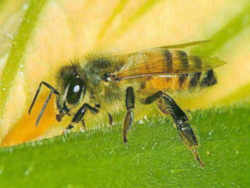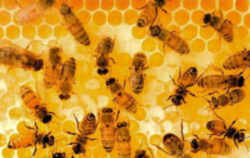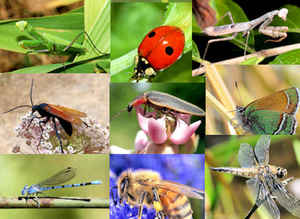
Arkansas Symbols
Arkansas State Insect
Honeybee

(Apis mellifera)
Adopted in 1973.
On February 1, 1973, Act 49 of the state General Assembly designated the honeybee, (Apis mellifera,) as the state's official insect. Introduced by Representative Albert "Tom"Collier of Jackson County, the legislation took note of the bee's important role in crop pollination but primarily extolled the bee's virtues of diligence, hard work, attention to home defense, and productivity. Act 49 said this "diligent and willing worker typifies the outstanding citizens of the state of Arkansas."
Arkansas's designation of the honeybee (Apis mellifera) as a state emblem placed it in the company of fifteen states that have so honored the insect. Several states, such as Oklahoma and Tennessee, have designated multiple insects as state symbols, pairing the laboring honeybee with such graceful "ornamental"insects as butterflies or dragonflies.
Honeybees carry pollen from flower to flower, and is is critical to plant and human survival. The bees also produce honey and bee's wax which is collected and sold by beekeepers. An old-fashioned dome beehive is one of the symbols on the Great Seal of Arkansas.
Did you know that: The honey bee has been proclaimed the official state insect in each of the following states:
Arkansas | Georgia | Kansas
| Kentucky | Louisiana
Maine | Mississippi |
Missouri | Nebraska | New Jersey
North Carolina | Oklahoma | South
Dakota | Tennessee
Utah | Vermont | West Virginia
| Wisconsin
Arkansas State Insect: Honeybee

Arkansas has long been a significant producer of honey, much of it packed and sold by local apiaries for local consumption. In 2001, when honey sale prices were at a temporary high, Arkansas ranked eighth among honey-producing states. By 2004, Arkansas had slipped to eighteenth, producing 2.28 million pounds. This trend reflected a decline in the number of producing colonies and production per colony. The Arkansas State Plant Board asserts that one-third of food crops rely on natural bee-borne pollination; of this, about eighty percent is accomplished by honeybee colonies. Decline in market prices has forced some apiaries out of business, and other colonies have disappeared through attrition.
Another factor complicating Arkansas's relationship with its state insect has been the advent of Africanized honeybees, sometimes called "killer bees."Developed in the 1950s by Brazilian apiarists, these bees are hybrids of the standard European honeybee with selected strains from southern Africa. The result was a bee that produced good quantities of honey in hot climates but exhibited heightened defensive tendencies. Released into the wild by accident, the hybrid bees spread through South and Central America in the 1970s and 1980s and reached the United States by 1990.
By June 2005, Africanized bee colonies were established in several Oklahoma counties bordering Arkansas; in the next month, several were found in Miller and Lafayette counties, with isolated swarms reported in three other counties. Prompt action by the Arkansas State Plant Board, working with the Arkansas Africanized Honey Bee Action Committee, has led to educational programs throughout the state. Pest control specialists have been authorized to exterminate colonies and swarms when encountered; because Africanized bees are mainly indistinguishable from "regular"European honeybees save by observed behavior or DNA analysis, this policy may result in the inadvertent destruction of populations of the latter.
Characteristics of the Honey Bee
Bees produce honey as food stores for the hive during the long months of winter when flowers aren't blooming and therefore little or no nectar is available to them. European honey bees, genus Apis Mellifera, produce such an abundance of honey, far more than the hive can eat, that humans can harvest the excess. For this reason, European honey bees can be found in beekeeper's hives around the world!
The taste, color and nutrient content of honey varies from place to place depending upon the kind of flora growing in the area. For example, Tupelo honey (from Tennessee) is twice as sweet as most honey. Many people take honey from their own neighborhood as a kind of natural antihistamine.
Honeybees probably originated in Tropical Africa and spread from South Africa to Northern Europe and East into India and China. They were brought to the Americas with the first colonists and are now distributed world-wide. The first bees appear in the fossil record in deposits dating about 40 million years ago in the Eocene. At about 30 million years before present they appear to have developed social behavior and structurally are virtually identical with modern bees.
Colony:
Honey bees are social insects, with a marked division of labor between the various types of bees in the colony. A colony of honey bees includes a queen, drones and workers.
The Queen:
The queen is the only sexually developed female in the hive. She is the largest bee in the colony.
A two-day-old larva is selected by the workers to be reared as the queen. She will emerge from her cell 11 days later to mate in flight with approximately
18 drone (male) bees. During this mating, she receives several million sperm cells, which last her entire life span of nearly two years.
The queen starts to lay eggs about 10 days after mating. A productive queen can lay 3,000 eggs in a single day.
The Drones:
Drones are stout male bees that have no stingers. Drones do not collect food or pollen from flowers. Their sole purpose is to mate with the queen. If the colony is short on food, drones are often kicked out of the hive.
The Workers:
Workers, the smallest bees in the colony, are sexually undeveloped females. A colony can have 50,000 to 60,000 workers.
The life span of a worker bee varies according to the time of year. Her life expectancy is approximately 28 to 35 days. Workers that are reared
in September and October, however, can live through the winter.
Workers feed the queen and larvae, guard the hive entrance and help to keep the hive cool by fanning their wings. Worker bees also collect nectar to
make honey. In addition, honey bees produce wax comb. The comb is composed of hexagonal cells which have walls that are only 2/1000 inch thick, but
support 25 times their own weight.
Honey bees' wings stroke 11,400 times per minute, thus making their distinctive buzz.
Arkansas Code
The law designating the honeybee as the official Arkansas state insect is found in the Arkansas Code, Title 1, Chapter 4, Section 1-4-110.
Arkansas Code (Non annotated)
Title 1 General Provisions
Chapter 4 State Symbols, Motto, Etc.
1-4-110.State insect.
The honeybee is designated as the official state insect for the State of Arkansas.
History.Acts 1973, No. 49, § 1; A.S.A. 1947, § 5-118.
Taxonomic Hierarchy: Western Honey Bee
Kingdom: Animalia (Animals)
Phylum: Arthropoda (Arthropods)
Subphylum: Hexapoda (Hexapods)
Class: Insecta (Insects)
Order: Hymenoptera (Ants, Bees, Wasps and Sawflies)
No Taxon: (Aculeata - Ants, Bees and Stinging Wasps)
No Taxon: (Anthophila (Apoidea) - Bees)
Family: Apidae (Cuckoo, Carpenter, Digger, Bumble, and Honey Bees)
Subfamily: Apinae (Honey, Bumble, Long-horned, Orchid, and Digger Bees)
Tribe: Apini (Honey Bees)
Genus; Apis
Species: mellifera (Western Honey Bee)
Butterflies, and Bugs







